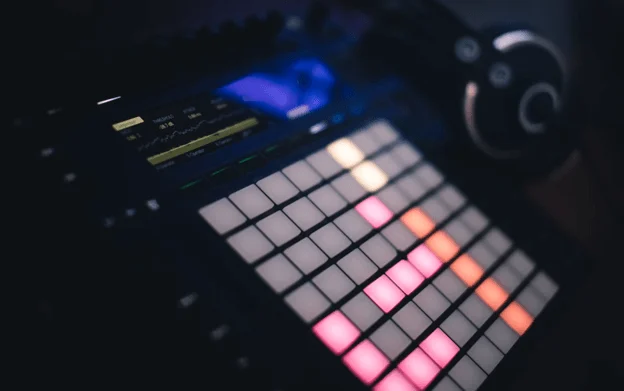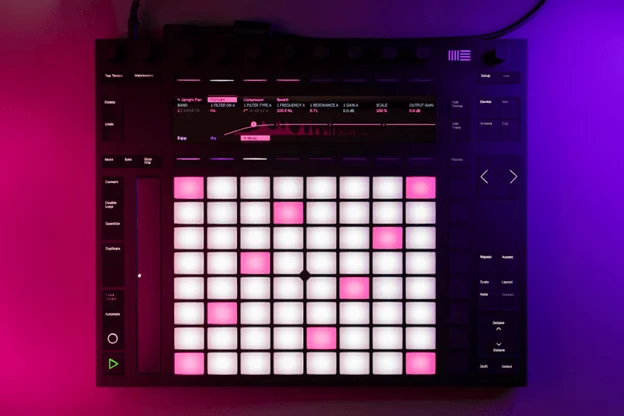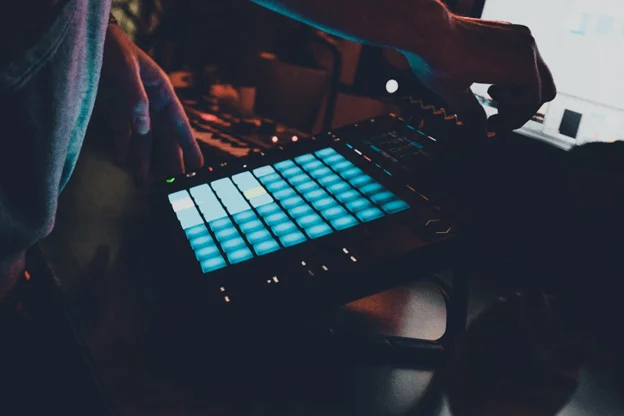MIDI controller keyboards offer music-makers creative control over sounds. For musicians and producers alike, knowing the ins and outs of these devices helps you make better compositions.
Whether you’re just starting or are a pro, understanding MIDI controllers open new musical worlds. Their abilities can streamline your workflow and boost creative output.
This guide will go over the key details of MIDI controller keyboards. We’ll look at their features and functions, use them, and expert tips to master these highly flexible tools.

What’s a MIDI Controller Keyboard?
Essentially, a MIDI controller keyboard links physical keys to digital realms of virtual instruments and software synthesizers. Unlike standard keyboards or pianos, MIDI controllers don’t make sounds alone. They send MIDI (Musical Instrument Digital Interface) signals to external devices like computers or synthesizers, generating the desired tones.
These controllers come in diverse sizes – from compact 25-key models to mammoth 88-key versions. Every model has unique features and functions, catering to musicians’ and producers’ varied requirements.
Key Features to Consider
When selecting a MIDI controller keyboard, several key features should be considered:
1. Key Count
Keys on MIDI controllers matter a lot. Their number decides how wide their abilities stretch. Less keys make it compact and easy to carry. But more keys give more tones for complex music-making. 25-key models are tiny, portable. Yet those with 49, 61, and 88 keys offer complex compositions.
2. Key Action
Different key actions offer unique playing experiences. Some have weighted keys simulating acoustic pianos, giving pianists a great feel. Other semi-weighted models strike a balance between realism and responsiveness. Meanwhile, synth-action keys bring a lightweight and springy experience – great for electronic producers.
3. Pads and Knobs
Many MIDI controllers come equipped with extra pads, knobs, sliders, and buttons. This expands their capabilities beyond regular piano keys. These assignable controls let you control different parameters, including volume, pitch, modulation, etc. This adds depth and expression to your performances.
4. Connectivity
Easy connection to your gear is key. Most MIDI controllers have USB ports for plugging into your computer. They also have MIDI DIN ports for linking to hardware synths or sound modules. There are pedal jacks so you can seamlessly use expression pedals, sustain pedals, and other accessories.

Functions and Controls
Once you’ve selected a MIDI controller keyboard, familiarizing yourself with its functions and controls is important to unlocking its full potential; this includes:
1. MIDI Mapping
MIDI controllers let you customize controls like keys and knobs. You can assign functions that fit how you work. This versatility helps boost your creative flow and productivity.
2. Velocity Sensitivity
Velocity sensitivity lets you control sound to your desire. Press keys softly for quieter notes. Hammer them for bold, forceful ones. This range copies real instruments. So you can play with more feeling and expression. Soft or intense. Gentle or passionate. Your keyboard captures every complex stroke.
3. Aftertouch
Aftertouch is a handy function found on certain MIDI controllers. It lets you apply extra pressure to keys after you’ve pressed them. This extra pressure triggers cool effects like vibrato, tremolo, or filter sweeps.
4. Pitch Bend and Modulation Wheels
Pitch bend and mod wheels are key to MIDI gear. The pitch wheel bends notes up or down. And the mod wheel shapes the tone. So these simple controls give smooth, hands-on control over expression – from wild pitch swoops to slight shifts in tone.
Nowadays, making music is a walk in the park thanks to MIDI controller keyboards. These cutting-edge tools connect with most modern music production software. They bring out your creative flow and enables you to truly immerse yourself in musical creativity. Here’s what you need to know:
1. Compatibility
Music production software like Ableton Live, Logic Pro, FL Studio, and Pro Tools effortlessly connect with MIDI controllers. Ableton’s session views offers’ flexibility, while Logic Pro delivers an industry-standard workflow. Whichever program you favor, a MIDI controller gets the job done.
2. Bundled Software
Most MIDI controllers offer software packages that match their capabilities. These bundles frequently feature virtual instruments, synths, and effects plugins – a one-stop toolkit for music creation.
3. Dedicated Templates
MIDI controllers often come with dedicated templates tailored for certain software. These templates match controller knobs and buttons to software settings. This way, the controller works perfectly with the program from the get-go, letting you effortlessly tweak virtual instruments and effects.
4. Automapping
Learning MIDI controllers can be tricky – there are so many knobs and buttons to figure out. Fortunately, some controllers have an amazing feature called automapping. It assigns functions automatically, so you don’t need to spend hours setting things up.

Tips for Getting Started
Are you ready to embark on your journey with a MIDI controller keyboard? Here are some quick tips to help you hit the ground running:
1. Experiment
Don’t be afraid to explore different sounds, effects, and control mappings to discover your unique musical voice. The beauty of MIDI controllers lies in their versatility and adaptability. So, don’t hesitate to push the boundaries of creativity.
2. Practice Regularly
Like any instrument, mastering a MIDI controller requires lots of practice and dedication. Set aside time to sharpen your skills, experiment with new techniques, and refine your talent.
3. Learn MIDI Basics
Understanding the basics of MIDI, such as channels, notes, and controllers, will empower you to harness the full potential of your MIDI controller keyboard. Consider online tutorials, guides, and resources to deepen your understanding and expand your skills.

Conclusion
MIDI controller keyboards are powerful for musicians and producers. They offer several features and functions to enhance creativity and workflow. By understanding the key features, functions, and software integration options, you can make the most of your MIDI controller and take your music production to new heights.

Jessi is the creative mind behind The Coffee Mom, a popular blog that combines parenting advice, travel tips, and a love for all things Disney. As a trusted Disney influencer and passionate storyteller, Jessi’s authentic insights and relatable content resonate with readers worldwide.
